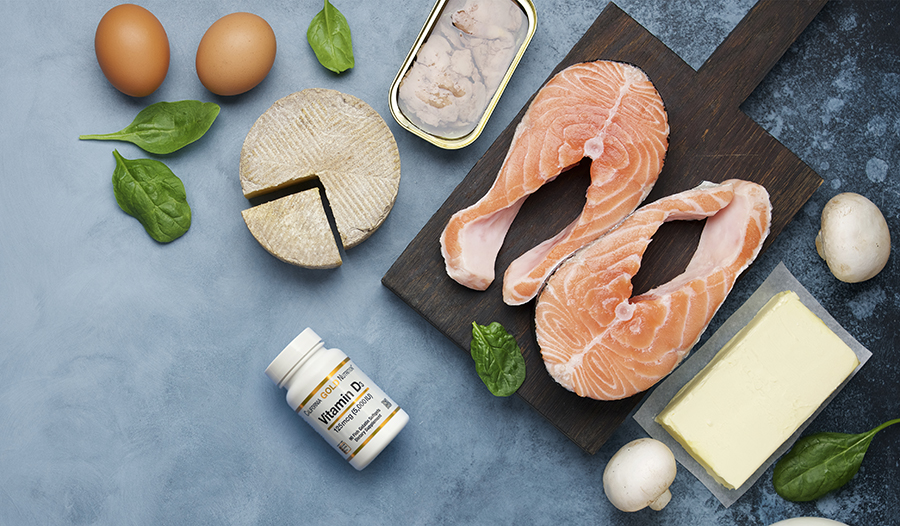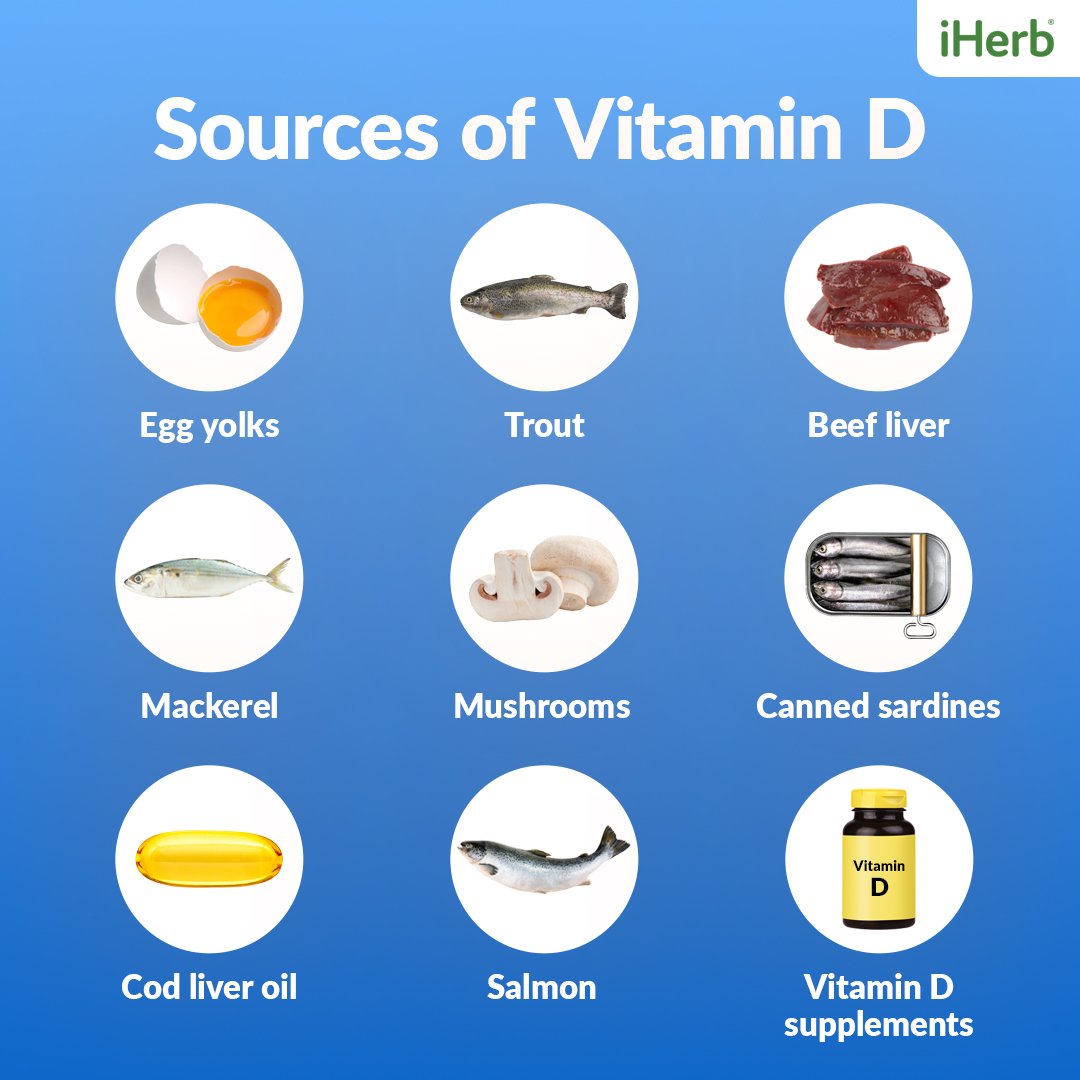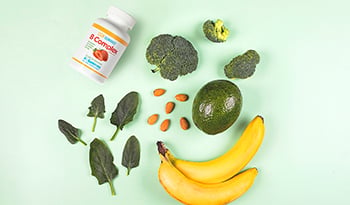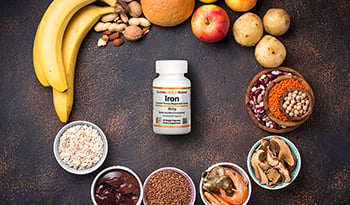Which Foods Are High In Vitamin D?
DISCLAIMER:This blog does not intend to provide diagnosis...
- In this article:
- What Does Vitamin D Do In The Body?
- How Much Vitamin D Do You Need?
- What Are The Signs and Symptoms of Vitamin D Deficiency?
- 6 Foods That Contain Vitamin D
- Vitamin D Supplements
- Vitamin D Toxicity

Vitamin D is a fat-soluble vitamin that serves many vital functions in the body. It’s a unique nutrient in that we get it from food sources but it’s also something that our bodies make. In fact, there are three ways that we can get vitamin D—from the sun, from food, and from vitamin D supplements.
Exposure to ultraviolet rays triggers the conversion of cholesterol in our skin to vitamin D3, a form of vitamin D. D3 then enters the blood and is transported to the liver and kidneys where it is converted to its bioactive form (calcitriol). Because our bodies make vitamin D naturally from sun exposure to the skin, it is often referred to as the Sunshine Vitamin.
What Does Vitamin D Do In The Body?
Most of us recognize vitamin D as being important for bone growth, which it certainly is. Vitamin D aids in the absorption of calcium, helping to form and maintain strong bones. When you don’t get enough vitamin D, it puts you at risk for diseases such as rickets in children and osteomalacia in adults. That’s why the US government started fortifying milk with vitamin D in the 1930s—rickets was a major health problem at the time.
But vitamin D is not just critical for healthy bones—it actually has several other important functions in the body including keeping your muscles, nerves, and immune system healthy and modulating proper cell growth. Also, it may decrease the risk of certain types of autoimmune diseases such as multiple sclerosis and offers protection against diabetes, cardiovascular disease, dementia, and certain types of cancer. However, much of this evidence has come from observational studies so more interventional studies on vitamin D supplementation need to be done to determine vitamin D’s role in these diseases.
How Much Vitamin D Do You Need?
Life Stage | Recommended Amount |
Birth to 12 months | 10 mcg (400 IU) |
Children 1-13 years | 15 mcg (600 IU) |
Teens 14-18 years | 15 mcg (600 IU) |
Adults 19-70 | 15 mcg (600 IU) |
Adults 71 years and older | 20 mcg (800 IU) |
Pregnant and breastfeeding women | 15 mcg (600 IU) |
Currently, there is a lot of scientific debate over what the optimal amount of vitamin D is. The official Recommended Dietary Allowance (RDA) set by the Institute of Medicine (IOM) is 600 International Units (IU) per day for adults aged 19-70 years and 800 IU for those over age 70. The RDA provides the daily amount needed to maintain healthy bones and normal calcium metabolism in healthy people and is based on minimal sun exposure. But many groups recommend much larger amounts of vitamin D based on the most current research. For example, the Endocrine Society recommends as much as 1,500 IU to 2,000 IU per day to achieve adequate serum levels of vitamin D.
What Are The Signs and Symptoms of Vitamin D Deficiency?
What are the best ways to get an adequate amount of vitamin D? One way is through exposure to sunlight. Just 10-15 minutes of sunlight exposure can provide 3,000-20,000 IU. The problem is that the amount of vitamin D we get from sun exposure varies considerably depending on several factors including geographic latitude and skin color. Sunlight is generally weaker in northern latitudes, leading to less vitamin D synthesis. Also, people with darker skin tones generally need a lot more sun exposure to synthesize vitamin D, as melanin reduces the skin’s ability to produce vitamin D from sunlight.
Vitamin D deficiency has reemerged as a global health concern. About one billion people worldwide have vitamin D deficiency. Some experts believe that low intake of the vitamin coupled with behaviors that limit UV-light exposure (such as time spent indoors, the use of sunscreen, and the use of protective clothing to fully cover the skin) have resulted in widespread inadequate vitamin D status. Elderly people and individuals who are hospitalized or reside in nursing homes are especially at risk. Not only do many of them have inadequate sun exposure, but they also may have limited dietary intake and/or impaired kidney function, which limits the conversion of vitamin D to its active form.
Many patients with vitamin D deficiency are asymptomatic. Others may experience signs or symptoms such as muscle pain or cramps, bone pain, weakness, fatigue, and mood changes. With prolonged vitamin D deficiency, infants and children can develop rickets, a condition characterized by soft bones and skeletal deformities such as bowed legs. In adults, prolonged vitamin D deficiency can cause osteomalacia, which is characterized by weak, soft bones and can result in frequent fractures.
6 Foods That Contain Vitamin D
In the absence of UV-light exposure, an adequate intake of vitamin D is essential to prevent deficiency. However, there are relatively few natural food sources of vitamin D. Fortified foods provide most of the vitamin D in the American diet. Here are the best food sources of vitamin D.

1. Fatty Fish Like Salmon, Trout, and Mackerel
A 3-ounce serving of rainbow trout provides 645 IU of vitamin D, which is more than 100 percent of your daily requirement. Fresh salmon ranges from 383-570 IU per three ounces depending on the type of salmon. Some studies show that wild salmon may contain much higher amounts of vitamin D than farmed. Other fresh fish that are high in vitamin D are halibut, carp, swordfish, and catfish.
2. Canned Fish Like Tuna, Sardines, and Herring
Canned fish also have high amounts of vitamin D, so if fresh seafood isn’t an option then try canned, which is typically also less expensive. Three ounces of canned light tuna in water contains around 154 IU of vitamin D.
Canned tuna does contain methylmercury, a toxin found in many types of fish. However, certain types of tuna, such as light tuna, pose a lower risk. It’s considered safe to eat up to six ounces of canned tuna per week.
Three ounces of canned sardines in oil contains 164 IU of vitamin D. Pickled herring is also a good source of the vitamin but can contain high amounts of sodium.
3. Cod Liver Oil
Cod liver oil is extracted from the liver of codfishes. Historically, it was used widely beginning in the 1920s to prevent and treat rickets. One tablespoon of cod liver oil packs 1360 IU of vitamin D.
4. Mushrooms
Except for fortified foods, mushrooms are the only natural vegetarian source of vitamin D. Similar to humans, mushrooms synthesize vitamin D when exposed to UV light. Mushrooms, however, produce a different form of the vitamin than humans—they produce D2 instead of D3.
For mushrooms that are grown in the wild, the synthesis of vitamin D occurs naturally from the sun. In commercially grown mushrooms, this occurs with exposure to UV lamps.
Although commercially grown mushrooms are typically grown in the dark, exposing them to UV light after harvest greatly boosts their vitamin D content. A cup of cremini mushrooms exposed to UV light contains a whopping 1110 IU of vitamin D.
5. Eggs
Eggs are a convenient way to get vitamin D and can be incorporated into a wide variety of recipes. However, keep in mind that the vitamin D in eggs is found in the yolk, not the white—so don't ditch those yolks!
One egg yolk provides about 41 IU. The USDA found that eggs contain 64% more vitamin D now than they did when they were previously analyzed by the government in 2002. This has to do with changes in the diet of chickens by egg producers such as the use of vitamin D-enriched feed. Also, free-range eggs, which come from chickens that are allowed to roam outdoors, contain substantially higher amounts of vitamin D than eggs from chickens that are kept indoors.
6. Fortified Foods
Fortified foods are those that have nutrients added to them that don't naturally occur in the food. Since so few foods naturally contain vitamin D, fortified foods provide most of the vitamin D found in our diet. Most cow’s milk is fortified with about 120 IU of vitamin D per cup. Milk is also an excellent source of calcium. For those who don’t drink dairy milk, plant milk alternatives (like soy, almond, and oat) are also often fortified with similar amounts of vitamin D.
Enjoying a glass of orange juice to start your days is also a good way to boost your vitamin D intake. One cup of fortified orange juice provides about 100 IU of vitamin D but varies by brand. Some cereals and instant oatmeal are also fortified with vitamin D. And if you enjoy your cereal with some fortified milk, you’re getting a double dose of vitamin D.
Yogurt is a convenient, nutrient-packed snack that provides calcium, protein, and gut-friendly probiotics. A serving of yogurt provides about 10-20% of your daily vitamin D requirement, depending on the type and brand. Tofu can be a good source of vitamin D for vegans, who may struggle to meet their vitamin D recommendations. Not all tofu is fortified but those that are offered around 100 IU per 3.5 ounces.
Vitamin D Supplements
If you are concerned that you are still not getting enough vitamin D through sun exposure and food sources, you can take a vitamin D supplement. The vitamin D found in supplements comes in two different forms: vitamin D2 (ergocalciferol), which comes from plant sources, and vitamin D3 (cholecalciferol), which comes from animal sources. Both are well absorbed in the gut and increase vitamin D levels in the blood. However, most evidence indicates that vitamin D3 raises blood levels of the vitamin more and sustains those levels longer than D2.
Certain groups are at higher risk for vitamin D deficiency and should consider taking a supplement. These groups are:
- Breastfed infants: Human milk is a poor source of vitamin D.
- Older adults: Their skin is less efficient at making vitamin D when exposed to the sun and their kidneys don’t convert the vitamin to its active form as well.
- People with limited sun exposure, such as individuals who are homebound, hospitalized, or nursing home residents, those who wear sun-protective clothing, and those with occupations that limit time outside.
- People with dark skin: Melanin in the skin reduces the skin’s ability to make vitamin D.
- People with conditions that limit fat absorption, such as cystic fibrosis, Crohn’s disease, or celiac disease: Vitamin D needs fat to be absorbed properly in the gut.
- People who are obese: Body fat binds some of the vitamin D, preventing it from getting into the blood.
- People who have had gastric bypass surgery: Part of the upper small intestine where vitamin D is absorbed gets bypassed after surgery.
Vitamin D Toxicity
Vitamin D can be harmful when amounts in the blood become too high. The Tolerable Upper Intake Level (UL) is the maximum daily intake of a nutrient that’s unlikely to cause harmful effects on health. The UL for vitamin D for adults and children ages 9+ is 4,000 IU.
When vitamin D toxicity occurs, it is typically from taking supplements. The low amounts of vitamin D found in foods are unlikely to reach a toxic level. And prolonged sun exposure is unlikely to cause toxicity because the body has inherent mechanisms to limit the amount of vitamin D it produces.
Symptoms and signs of vitamin D toxicity include nausea, vomiting, lack of appetite, constipation, weight loss, weakness, confusion, irregular heartbeat, and damage to the heart and kidneys. It is advised to not take daily vitamin D supplements containing more than 4,000 IU unless it’s under the supervision of your doctor.
References:
- Carol Byrd-Bredbenner and Gaile Moe and Jacqueline Berning and Danita Kelley. Wardlaw's Perspectives in Nutrition 11th Edition. McGraw Hill, 2019.
- Food and Nutrition Board, Institute of Medicine. Dietary Reference Intakes for calcium and vitamin D. Washington, DC: National Academies Press; 2011.
- Lappe JM, Heaney RP. The anticancer effect of vitamin D: What do the randomized controlled trials show? In: Holick MF, ed. Nutrition and health: vitamin D. New York: Springer Science and Business Media; 2010.
- Buell JS et al. 25-hydroxyvitamin D, dementia and cerebrovascular pathology in elders receiving home services. Neurol. 2010; 74:18.
- Wimalawansa SJ. vitamin D in the new millennium. Curr Osteoporos Rep. 2012; 10:4.
- Bair T et al. Association between vitamin D deficiency and prevalence of cardiovascular disease. J Am Coll Cardiol. 2010;55: A141.
- Holick MF et al. Guidelines for preventing and treating vitamin D deficiency and insufficiency revisited. J Clin Endocrinol Metab. 2012; 97:2011.
- Ascherio A et al. vitamin D as an early predictor of multiple sclerosis activity and progression. JAMA Neurology. 2014; 71:306.
- Lappe JM et al. vitamin D and calcium supplementation reduces cancer risk: Results of a randomized controlled trial. Am J Clin Nutr. 2007; 85:1586.
- https://ods.od.nih.gov/factsheets/VitaminD-Consumer
- Holick MF, Binkley NC, Bischoff-Ferrari HA, et al. Evaluation, Treatment, and Prevention of vitamin D Deficiency: an Endocrine Society Clinical Practice Guideline. J Clin Endocrinol Metab. 2011 Jun 6.
- Nair R, Maseeh A. vitamin D: The "sunshine" vitamin. J Pharmacol Pharmacother. 2012 Apr;3(2):118-26
- https://ods.od.nih.gov/pubs/usdandb/VitaminD-Content.pdf
- Jakobsen J, Smith C, Bysted A, Cashman KD. vitamin D in Wild and Farmed Atlantic Salmon (Salmo Salar)-What Do We Know?.Nutrients. 2019;11(5):982. Published 2019 Apr 29. doi:10.3390/nu11050982
- Lu Z, Chen TC, Zhang A, et al. An evaluation of the vitamin D3 content in fish: Is the vitamin D content adequate to satisfy the dietary requirement for vitamin D?. J Steroid Biochem Mol Biol. 2007;103(3-5):642-644. doi:10.1016/j.jsbmb.2006.12.010
- Burger J, Gochfeld M. Mercury in canned tuna: white versus light and temporal variation. Environ Res. 2004 Nov;96(3):239-49. doi: 10.1016/j.envres.2003.12.001. PMID: 15364590.
- Cardwell G, Bornman JF, James AP, Black LJ. A Review of Mushrooms as a Potential Source of Dietary vitamin D. Nutrients. 2018;10(10):1498. Published 2018 Oct 13. doi:10.3390/nu10101498
- Kühn J, Schutkowski A, Kluge H, Hirche F, Stangl GI. Free-range farming: a natural alternative to produce vitamin D-enriched eggs. Nutrition. 2014 Apr;30(4):481-4. doi: 10.1016/j.nut.2013.10.002. Epub 2013 Oct 14. PMID: 24607306.
- Calvo MS, Whiting SJ, Barton CN. vitamin D fortification in the United States and Canada: Current status and data needs. Am J Clin Nutr 2004;80:1710S-6S.
- Exler J, Phillips K, Patterson K, Holden J. Cholesterol and vitamin D content of eggs in the U.S. retail market. J Food Compost Anal 29 (2013) 110–116
- https://www.prnewswire.com/news-releases/eggs-are-now-naturally-lower-in-cholesterol-115547959.html
- Tripkovic L, Lambert H, Hart K, Smith CP, Bucca G, Penson S, et al. Comparison of vitamin D2 and vitamin D3 supplementation in raising serum 25-hydroxyvitamin D status: A systematic review and meta-analysis. Am J Clin Nutr 2012;95:1357-64.
- Lehmann U, Hirche F, Stangl GI, Hinz K, Westphal S, Dierkes J. Bioavailability of vitamin D2 and D3 in healthy volunteers, a randomised placebo-controlled trial. J Clin Endocrin Metab 2013;98:4339-45.
- Logan VF, Gray AR, Peddie MC, Harper MJ, Houghton LA. Long-term vitamin D3 supplementation is more effective than vitamin D2 in maintaining serum 25-hydroxyvitamin D status over the winter months. Br J Nutr 2013;109:1082-8.
- Tripkovic L, Wilson LR, Hart K, Johnsen S, de Lusignan S, Smith CP, et al. Daily supplementation with 15 µg vitamin D2 compared with vitamin D3 to increase wintertime 25-hydroxyvitamin D status in healthy South Asian and white European women: A 12-wk randomized, placebo-controlled food-fortification trial. Am J Clin Nutr 2017;106:481-90.
- Picciano MF. Nutrient composition of human milk. Pediatr Clin North Am 2001;48:53-67.
- Chalcraft JR, Cardinal LM, Wechsler PJ, Hollis BW, Gerow KG, Alexander BM, et al. vitamin D synthesis following a single bout of sun exposure in older and younger men and women. Nutrients 2020; 12, 2237; doi:10.3390/nu12082237.
- Silva MC, Furlanetto TW. Intestinal absorption of vitamin D: A systematic review. Nutr Rev 2018;76:60-76.
- Chakhtoura M, Rahme M, Fuleihan E-H. vitamin D metabolism in bariatric surgery. Endocrinol Metab Clin North Am 2017;46:947-82.
- Peterson L, Zeng X, Caufield-Noll CP, Schweitzer MA, Magnuson TH, Steele KE. vitamin D status and supplementation before and after bariatric surgery: A comprehensive literature review. Surg Obes Relat Dis 2016;12:693-702

 By Dr. Sonali Ruder, D.O.
By Dr. Sonali Ruder, D.O.


